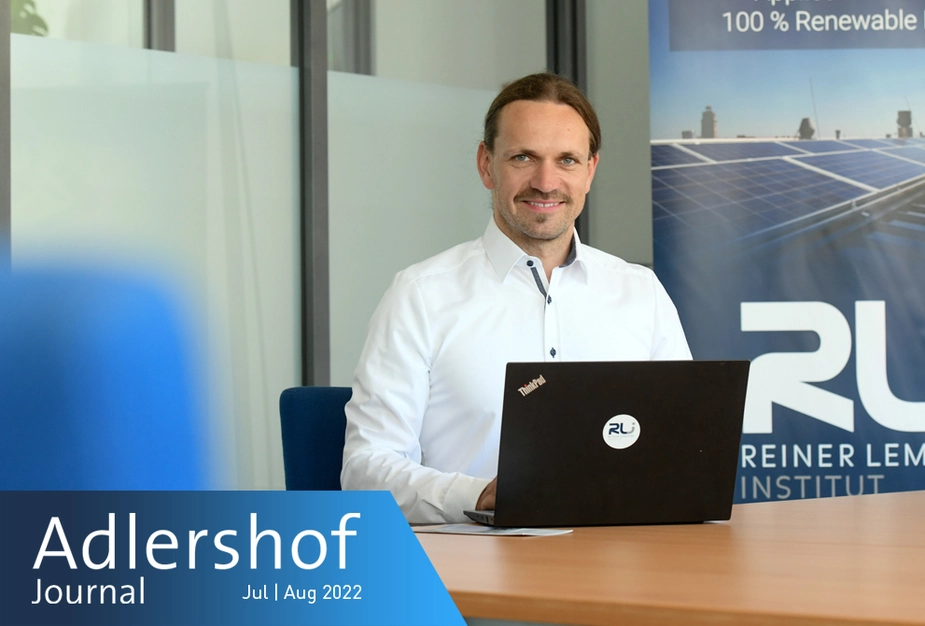Advancing the energy transformation with hydrogen
Year-round storage for buildings and as a regional energy source – how two Adlershof-based companies are fostering the gas’s practical applications
A typical summer day in Adlershof: blue skies, a few clouds, the sun is shining. Shining on the free-standing solar cells along Rudower Chaussee. Their electricity charges a car, while the rest disappears into an inconspicuous box. The energy then returns through a thin tube and is fed into steel cylinders. “Hydrogen is much better suited for long-term storage than batteries,” says Nils Boenigk from HPS Home Power Solutions. The company has developed such storage for single-family houses and small businesses.
Founded in Adlershof in 2014, HPS aims at securing the supply for an entire year. “On a sunny day like today, the batteries fill up quickly. The rest is fed into the grid,” explains the company’s head of communications. The batteries empty quickly due to use by washing machines, computers, heat pumps, or through self-discharge. This is not a problem in summer because the sun soon returns. It does not in Winter, however.
This gap is to be closed by converting self-produced green energy into hydrogen. To do so, a device the size of a cupboard, dubbed picea, is equipped with an electrolyser that splits water: into oxygen that dissipates into the environment and hydrogen that is fed into steel cylinders. They are located in variable modules outside the house. The modules adhere to high safety standards; even a fire or the impact of a truck would not cause an explosion. When needed, picea retrieves the gas from there and turns it back into electricity using a fuel cell. The waste heat from the equipment is used for heating and hot water. Picea is the world’s first market-ready, year-round, hydrogen-based electricity storage system for buildings.
Before they are sent out, the storage facilities are thoroughly tested in Adlershof. Walking through the company’s corridors, it is striking how many young people work here. Diversity is important and a real thing at the company, says Boenigk. Moreover, short pathways for decisions and communication are essential for highly motivated and fast-growing team that wants to jointly push forward the transition to clean energy (Energiewende).
250 systems have already been sold. Gross prices start at around 85,000 euros. However, says Boenigk, there are subsidies available and the increases in electricity prices should also be considered. “If we assume an annual increase in electricity prices of 3.5 percent, then the system can pay for itself after about 20 years.” Although picea achieves an overall utilisation rate of around 90 percent, the developers still have many plans. In future, Picea is to help stabilise local electricity grids. “With many solar systems on rooftops feeding into the grid, there can be bottlenecks, especially around noon,” Boenigk explains. With the “FlexEhome” project in cooperation with Technical University Berlin, HPS is now researching a single-family house that meets its electricity and heating needs at any point of the year solely through renewable energy generated by the building and can provide additional grid services to the surrounding electricity distribution grid.
While HPS uses hydrogen to advance the energy transition at individual buildings, Localiser RLI GmbH is looking at the entire value chain. “There are many companies seeking to offer hydrogen,” says Oliver Arnhold, the CEO. Wind parks, for example. On the other hand, demand is growing, say, in the industrial, heating, and transport sector. To help different actors to come together more quickly, Localiser, a spin-off of the Reiner Lemoine Institute, has created a digital hydrogen marketplace. The state governments of Berlin and Brandenburg officially launched it in late April.
Companies can put in essential data in a matter of minutes and can be found immediately. “It’s like a mix of a dating site and Craigslist,” says Arnhold with a wink, and proceeds to show how it works on a large screen: He uses a map to display potential providers. The map shows data on quantity forecasts and project statuses from planning and approval to operation. “This makes possible to identify potential business partners very quickly. More than 180 companies are now active in the marketplace and have posted offers and requests throughout Germany and Austria. More than 90,000 tons of hydrogen are already being offered after a very short time.”
This is also benefitting the state government. “The hydrogen market is young and growing, there are many uncertainties,” says Arnhold. The marketplace also highlights trends in where suppliers and buyers are located and what volumes of gas must be moved. “This serves as a basis to decided where pipelines construction would be most effective.”
Ralf Nestler for Adlershof Journal

